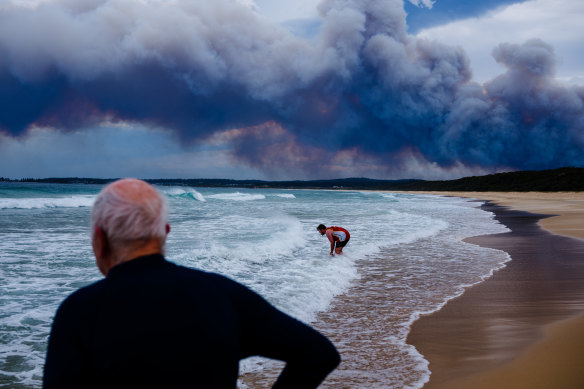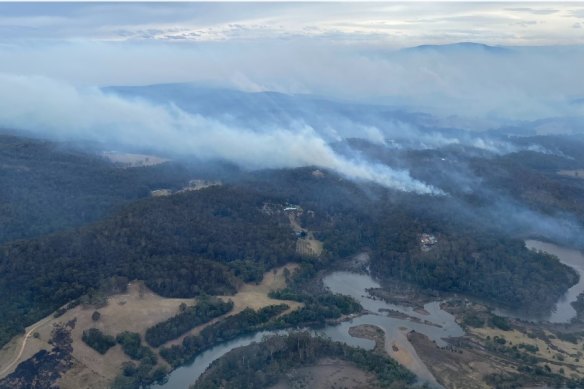Save articles for later
Add articles to your saved list and come back to them any time.
At least three homes have been destroyed by a South Coast fire that has blazed through more than 5000 hectares of land, the NSW Rural Fire Service says, as the prime minister and NSW premier visit the region.
More than 800 firefighters and emergency service personnel worked through the night to protect homes in rural areas and seaside hamlets near Bermagui.
Beachgoers look on as a fire burnt on the South Coast on Tuesday.Credit: James Brickwood
The alert for the Coolagolite fire was downgraded from emergency to watch and act about 1.30am on Wednesday, after a southerly came through the area about midnight. It was again downgraded to advice just after midday, as firefighters worked to contain the blaze with aircraft.
NSW RFS spokeswoman Angela Burford said bushfire burnt through more than 5000 hectares of land near Bermagui, but crews were helped when cooler temperatures, increased humidity and scattered rainfall came through the area.
“Firefighters were given the chance to slow the fire because, prior to that, they were all set up for property protection,” she said.
Coolagolite was one of the many towns that suffered during the 2019/20 summer bushfire crisis.
Al Ramos said firefighters told him to evacuate Dybara Park Cottages in Barragga Bay, 30 kilometres south of Narooma, about 2pm on Tuesday.
“I spent all night waiting for news and I’m still waiting,” he said.
“I went to Narooma overnight and slept in my car. I drove back today but the fire brigade has still blocked the roads so I’m now in Bermagui. I don’t know if my property was saved or burned.”
The South Coast blaze came after a fast-moving grass fire north of Mudgee in the Central West destroyed buildings and stock on Monday afternoon.
Extreme fire danger ratings were in place for Sydney and the Hunter region on Tuesday night as well as a swathe of the state’s interior stretching from the lower Central West plains to the Queensland border.
Temperatures reached 37.2 degrees at Sydney Airport about 2.30pm on Tuesday, with the city centre, Penrith, Gosford and Nowra all cracking 35 degrees.
Those highs are as much as 15 degrees above the October average maximum for the same locations, sparking dozens of new fires across the state.
As of 1.00pm, there were 62 bush and grass fires burning across the state with 22 yet to be contained. The Greater Hunter, Northern Slopes and North Western regions have total fire bans in place; the Greater Sydney region has a high fire danger rating.
An aerial of the Coolagolite fire burning near homes late Wednesday morning.Credit: NSW RFS
“Friday is when we will see a return to low to moderate fire danger,” Burford said.
“The southerly will very slowly move throughout south and western NSW and it’s very variable.”
Burford said firefighters would be alert to a number of fires in the north-eastern part of the state on Wednesday and there was still a risk some blazes could flare up to emergency levels.
“The Kearsley fire near Cessnock came very close to property [on Tuesday] and it was at an emergency level. That fire is not yet contained,” Burford said.
The emergency warnings are among the first for this bushfire season, which is expected to be the worst since the 2019/20 Black Summer.
The largest uncontrolled fire near Bredbo in the Snowy-Monaro region tripled in size to 1140 hectares under strong winds as firefighters, heavy machinery and aircraft tried to strengthen containment lines on Tuesday.
Winds exceeding 100km/h tore roofs off hotels and ski lodges at Smiggin Holes, Lake Crackenback and Perisher Valley.
NSW Premier Chris Minns said forecasts of a “horrific” bushfire season was one of the things that kept him up at night.
“I don’t want anybody to get over-confident – this could be a really tough bushfire season,” he said.
The premier and Prime Minister Anthony Albanese are visiting the South Coast on Wednesday to inspect the damage from the early fires.
“We know that the summer that we’re anticipating – and indeed it would appear we’re in right now even though it’s only October – is going to present some real challenges,” Albanese said.
“This is one of the reasons my government, together with state and territory governments, are determined to act on climate change. We also need to deal with the here and now and to improve preparedness.”
With AAP
Start the day with a summary of the day’s most important and interesting stories, analysis and insights. Sign up for our Morning Edition newsletter.
Most Viewed in National
From our partners
Source: Read Full Article




